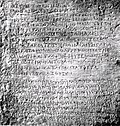Edicts of Ashoka
The Edicts of Ashoka are a collection of 33 inscriptions on the Pillars of Ashoka, as well as on large stones and cave walls, made by the Emperor Ashoka of the Mauryan dynasty during his reign from 272 to 231 BCE. The edicts describe in detail the first wide expansion of Buddhism. According to the edicts, the extent of Buddhist proselytism during this period reached as far as the Mediterranean, and many Buddhist monuments were created.
Ashoka did not completely forbid the killing of animals; he wanted to control the number of animals that had to be killed for human consumption or sacrificing, protected some of them, and in general criticized violent acts against animals, such as castration. He wrote these edicts on rock and pillar.
Edicts are royal orders or proclamations.These edicts were set up in different part of Ashoka's empire and spread the message of Ashoka's Dhamma.There are about 14 rock edicts and 7 pillar edicts currently found.
Edicts were written in local language. Most of the Ashoka's edicts are written in Brahmi Script and were translated by James Prinsep, a British official in 1837. After this major breakthrough, historians and scholars were able to obtain information about Ashoka and his reign.
Edicts Of Ashoka Media
Brahmi script consonants, and their evolution down to modern Devanagari, according to James Prinsep, as published in the Journal of the Asiatic Society of Bengal, in March 1838. All the letters are correctly deciphered, except for two missing on the right: 𑀰(ś) and 𑀱(ṣ).
The first known inscription by Ashoka, the Kandahar Bilingual Rock Inscription, in Greek and in Aramaic, written in the 10th year of his reign (260 BCE).[1]
The full title Devanampiyasa Piyadasino Asokaraja (𑀤𑁂𑀯𑀸𑀦𑀁𑀧𑀺𑀬𑀲 𑀧𑀺𑀬𑀤𑀲𑀺𑀦𑁄 𑀅𑀲𑁄𑀓𑀭𑀸𑀚) in the Gujarra inscription.
The four scripts used by Ashoka in his Edicts: Brahmi (top left), Kharoshthi (top right), Greek (bottom left) and Aramaic (bottom right).
The Prakrit word Dha-ṃ-ma (𑀥𑀁𑀫, Sanskrit: Dharma) in the Brahmi script, as inscribed by Ashoka in his Edicts. Topra Kalan pillar, now in New Delhi.
Animals pervade imperial Mauryan art. Rampurva bull capital established by Ashoka, 3rd century BCE. Now in the Rashtrapati Bhavan (Presidential Palace), New Delhi.
Ashoka and his two empresses, visiting the Bodhi Tree in Bodh Gaya, in a relief at Sanchi (1st century CE). The identification with Ashoka is confirmed by the similar relief from Kanaganahalli inscribed "Raya Asoka".
The Barabar caves were built by Ashoka for the ascetic sect of the Ajivikas, as well as for the Buddhists, illustrating his respect for several faiths. Lomas Rishi cave. 3rd century BCE.
References
- "The Edicts of King Asoka: An English Rendering" by Ven. S. Dhammika (The Wheel Publication No. 386/387) ISBN 955-24-0104-6
- “Zen living” by Robert Linssen ISBN 0-8021-3136-0
Other websites
| Wikimedia Commons has media related to Lua error in Module:Commons_link at line 62: attempt to index field 'wikibase' (a nil value).. |
- The Edicts of King Ashoka (full text, electronic edition offered for free distribution)
- The Edicts of King Ashoka Archived 2005-07-27 at the Wayback Machine in Access to Insight
- Edicts in original Gandhari
- King Asoka and Buddhism. Historical and Literary studies Archived 2012-09-23 at the Wayback Machine
- Inscriptions of India -- Complete listing of historical inscriptions from Indian temples and monuments








